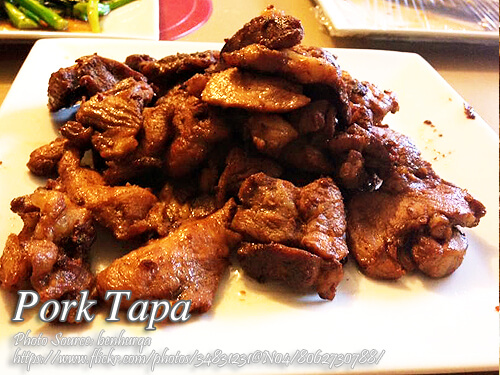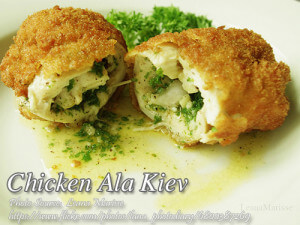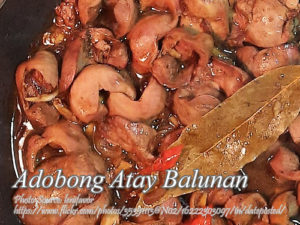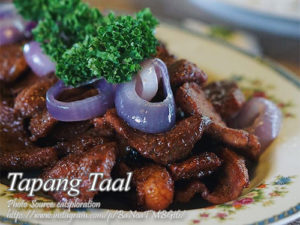Pork tapa is a variation of the popular beef tapa. Actually any meat could be made into tapa and there are some who make tapa out of horses, carabaos or other exotic meats. Compared to beef tapa, this tapa is of course a cheaper alternative and is similar in taste and texture compared to chicken meat.
One advantage of making your own tapa compared to buying it as frozen and ready to cook (of course you have to thaw it first), is, there are no preservatives and is cheaper because you made it yourself. Also you will notice that this tapa is sweet because the marinade contains sugar and Sprite. You can omit them if you don’t like a sweet version of tapa. Sprite is used to tenderize the meat and also adds savor when cooked but since the marinade has calamansi juice which does the same purpose of tenderizing the meat so you can omit it.
Pork Tapa: A Homemade Taste of Filipino Tradition
Growing up in the Philippines, tapa has always held a special place in our family meals, and pork tapa, in particular, is a household favorite. Unlike the more common beef tapa, which many are familiar with, this tapa offers a unique twist, capturing the same rich flavors with a subtle sweetness that melts into each bite. It’s a dish that brings memories of lazy Sunday brunches with the smell of garlic frying in the kitchen and my mother’s favorite fried rice cooking alongside it.
This tapa recipe has a simple marinade that keeps the meat tender and flavorful, thanks to a mix of classic Filipino ingredients like calamansi, garlic, and soy sauce. While some tapa recipes call for beef or even exotic meats like horse or carabao, this version of tapa is more affordable and readily available. For those new to Filipino cuisine or cooking in general, this recipe is a perfect entry point.
A Personal Take on Pork Tapa
My Uncle Rey, a great home cook, was the first to teach me how to make pork tapa. He always said that the key to great tapa isn’t just in the quality of the meat, but also in the marinade. He swore by adding a splash of Sprite, which might sound surprising, but it truly works wonders. The Sprite not only adds a bit of sweetness but also acts as a tenderizer, making the meat soft and juicy. If you’re not a fan of sweet flavors in your tapa, feel free to omit the Sprite and rely on calamansi, which tenderizes the pork just as well with its natural acidity.
Why Homemade Pork Tapa?
There’s something deeply satisfying about making your own tapa from scratch. Pre-packaged tapa is convenient, but making it at home means you can control exactly what goes into it. No preservatives, no artificial flavors—just pure, delicious flavors that remind you of home-cooked meals. Plus, homemade pork tapa is cheaper in the long run and tastes much fresher.
When you marinate the pork yourself, you can adjust the flavors to your liking. If you want a bit more sweetness, just add a touch more sugar. If you prefer a savory taste, increase the soy sauce slightly. My cousin Lina even likes to add a hint of chili for a spicy twist.
Marinating Tips for the Best Tapa
To get that deep, flavorful marinade, use thinly sliced pork. The thin cuts allow the marinade to penetrate the meat, which makes it more flavorful with every bite. Uncle Rey often recommends using a large zip-lock bag instead of a bowl for marinating, and now I can’t imagine doing it any other way. A zip-lock bag ensures that the meat is completely covered in the marinade, allowing it to soak up all the delicious flavors evenly. If you don’t have a bag handy, a bowl works just fine, but make sure to occasionally stir the meat while it marinates.
The secret to getting the best flavor is time. If you can, marinate the pork overnight. Letting the pork sit in the fridge for an extended period allows the flavors to infuse deeply, and you’ll taste the difference once it’s cooked. Just imagine the savory, garlicky scent wafting from the kitchen as you fry it the next day—absolutely worth the wait!
Cooking The Tapa to Perfection
When it’s time to cook the pork tapa, heat about a quarter cup of oil in a pan over low heat. This step is crucial: low heat helps tenderize the pork slowly while ensuring that it doesn’t dry out. Fry the tapa for about eight minutes, or until the meat turns a light brown color and is tender. It’s this slow, even cooking that brings out the best in the meat, giving it a delicate balance of tenderness and flavor.
Cooking pork tapa slowly in oil is a technique that helps lock in the moisture while still allowing the outside to become slightly crispy. If you fry it too quickly or over high heat, the meat can become tough, which is a common mistake among beginners. The right heat and timing ensure a juicy bite that bursts with flavor—a little trick I learned from my sister Mara, who always serves it with atchara and a fried egg on the side.
Serving Pork Tapa: A Hearty Filipino Breakfast
Nothing says Filipino comfort food quite like a plate of tapa served with garlic fried rice, a sunny-side-up egg, and a spoonful of atchara on the side. This combination, known as silog (short for tapsilog when served with tapa), is a breakfast staple in many Filipino households. My family, for instance, loves to sit down together on weekends and enjoy this meal with a side of tomatoes or a little soy sauce and vinegar for dipping.
Tapsilog has been a breakfast tradition across the Philippines, with each family adding its own touch to the dish. Some might add chili, while others might experiment with different marinades. For me, it’s the homemade version of pork tapa that always feels the most special. Not only does it remind me of my family’s unique recipe, but it also carries a taste of our heritage, something that pre-packaged versions just can’t offer.
A Brief History of Tapa
The origins of tapa in Filipino cuisine are interestingly rooted in necessity. Historically, tapa was a method of preserving meat. Meats were salted and dried to extend their shelf life in the tropical climate. Today, tapa is still enjoyed for its robust flavors, and the preservation method has evolved into marinating and frying instead of drying. This evolution in technique has made tapa one of the most beloved breakfast items in the Philippines.
Pork tapa is a delicious way to experience this traditional dish in a new, affordable way. With its balanced flavors of sweetness and savory richness, it’s no wonder tapa remains a beloved part of Filipino culinary heritage.
Do you want to try other versions of tapa? Try tapang taal recipe!
How to Make Pork Tapa Recipe
Ingredients
- 1 kilo pork loin with fat
- 1 head garlic minced
- 1/4 cup soy sauce
- 1/4 cup calamansi juice or lemon juice
- 1 Tbsp. brown sugar optional
- 1 1/2 cup Sprite or 7-up
- salt and pepper to taste
- cooking oil for frying
Instructions
How to make and cook Pork Tapa:
- If the pork is bought from the wet market, wash it in running water and drain for a few minutes.
- Slice the pork thinly, just like when you are slicing the meat when you are making beef tapa. Set aside.
- In a large bowl or any plastic container (just enough to put all the meat and the rest of the ingredients), put the pork, garlic, soy sauce, calamansi juice, sugar, sprite or 7-up, salt and pepper.
- Mix all the ingredients until the sugar is dissolved and the meat is coated with the marinade mixture.
- Marinate the meat in the fridge overnight. For best result, you can use a zip lock bag, put the meat and marinade and seal the bag instead of just using a bowl. This way the meat will be marinated evenly.
- To cook the pork tapa, heat about 1/4 cup of cooking oil and fry the meat on low heat for 8 minutes or until the pork is tender and light brown.
- Serve with fried rice, atchara and fried egg for a hearty breakfast or lunch.
Video
Notes
Cooking Tips for Perfect Tapa:
- Slice the pork thinly: To ensure even cooking and maximum flavor absorption, slice the pork into thin, uniform pieces. This allows the marinade to penetrate the meat thoroughly, resulting in tender and flavorful tapa.
- Marinate overnight: For the best results, marinate the pork overnight in the refrigerator. This extended marination time allows the flavors to meld together and tenderize the meat, resulting in a more delicious and succulent tapa.
- Adjust sweetness to taste: The sweetness of the tapa can be customized according to your preference. If you prefer a sweeter flavor, you can increase the amount of sugar in the marinade. Conversely, if you prefer a less sweet taste, reduce the sugar or omit it altogether.
- Don't overcook: This tapa should be cooked until it reaches a golden brown color, but be careful not to overcook it. Overcooking can result in tough and dry meat. Keep a close eye on the cooking process and remove the tapa from the heat once it is cooked through and nicely caramelized.
- Experiment with cooking methods: While pan-frying is the traditional method for cooking tapa, don't be afraid to experiment with other cooking techniques. Grilling or baking the tapa can add unique flavors and textures to the dish. Try different methods to find your favorite cooking style.






Can I use coke instead of Sprite or 7-up?
Hi Emeli, yes you can use 7-Up instead of sprite.
You can cook with marinade, but i’s not tapa anymore, its adobo hehe
oh, it makes sense now. hehehe. I’ve just asked about it. 😅🤣😂
How long can u leave this on marinade?
Hi Kamiko, you can leave it as long as you want but you have to freeze it.
What do you do with the leftover marinade? Do you cook the pork in the marinade to make a sauce or drain the pork and discard the marinade?
Hi Phil, just discard the marinade.
Is it okay if I include the marinade in cooking the meat?
Hi Cherry, you are welcome!
Thanks for this pork tapa recipe! I love the slightly sweet taste of this tapa!